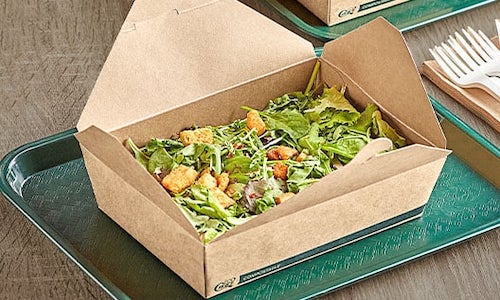
In today’s fast-paced world, food delivery and take-out dining have become an inseparable part of everyday life. Whether it’s a quick lunch at work or dinner brought straight to your door, disposable containers are essential for restaurants and catering services. But what are takeout boxes called, and how are they categorized within the food service industry?
This guide from Chefco, a leading Canada Restaurant Equipment Supplier, explores the take out container food service category classification and explains the differences between plastic, paper, and biodegradable options — helping you make smarter, more sustainable packaging choices for your business.

1. Disposable Plastic Take-Out Containers
When it comes to durability and affordability, plastic containers dominate the restaurant takeout container category classification. They’re lightweight, resistant to leakage, and can handle both hot and cold dishes — making them ideal for restaurants and food delivery businesses.
Foam Plastic Containers
Foam take-out boxes, made from expanded polystyrene (EPS), are known for their excellent insulation properties, keeping food warm longer. However, they come with significant environmental drawbacks. When heated above 65°C, foam plastics can release harmful substances like bisphenol A (BPA), which has raised health and environmental concerns worldwide. Moreover, their slow decomposition contributes to what’s known as “white pollution.”
Polypropylene (PP) Plastic Containers
PP containers, on the other hand, are a safer and more reliable choice. Made from food-grade polypropylene, they can withstand high temperatures without releasing toxins. Premium PP containers are clear, odorless, and suitable for reheating, while low-quality ones may produce a strong plastic odor or contain impurities.
Pros: Affordable, reusable, leak-proof, and heat-resistant.
Cons: Not biodegradable and may add to long-term plastic waste if not recycled properly.

2. Disposable Paper and Cardboard Boxes
Paper-based takeout boxes are a common sight in eco-conscious restaurants aiming to reduce plastic use. Typically made from kraft paper or cardboard, these containers are light, customizable, and give brands an earthy, sustainable appeal.
However, most paper boxes include a thin plastic or wax coating for waterproofing and grease resistance. While this makes them practical, it also means they are not fully recyclable or compostable. Additionally, large-scale paper production can contribute to deforestation and increased water consumption during processing.
Pros: Lightweight, great for branding, partially recyclable.
Cons: Can soften when holding wet foods; not fully biodegradable due to inner coating.
Paper boxes are best suited for dry foods like sandwiches, pastries, or salads, offering a balance between functionality and environmental responsibility within the take out container food service category classification.

3. Biodegradable Take-Out Containers
Sustainability is shaping the future of food packaging. Biodegradable takeout boxes are becoming the preferred choice for restaurants seeking eco-friendly solutions that align with global green initiatives.
Partially Biodegradable Containers
Often made from cornstarch-based polymers, these containers combine durability with sustainability. They are resistant to oil and moisture and do not release harmful chemicals. Authentic cornstarch containers typically have a light yellow hue and a subtle plant scent, while overly white versions may contain bleaching additives.
Fully Biodegradable Containers
Fully biodegradable boxes take sustainability one step further. Made from natural materials like bamboo fiber, sugarcane bagasse, or wheat straw, these boxes decompose naturally into water and carbon dioxide. They leave no toxic residue and have minimal environmental impact, making them an ideal choice for modern restaurants aiming for a green image.
Pros: Eco-friendly, compostable, safe for food contact.
Cons: Slightly higher cost compared to plastic or paper alternatives.
As environmental regulations tighten, these fully biodegradable boxes are expected to lead the restaurant takeout container category classification in the near future.

How to Choose the Right Take-Out Container
Choosing the right take-out box depends on your business needs and sustainability goals. Here are a few tips from Chefco to help guide your decision:
-
Match the container to your food type.
Hot, greasy dishes require heat-resistant materials like PP plastic, while cold or dry foods can use paper or biodegradable options. -
Consider eco-friendly alternatives.
Many customers now prefer restaurants that prioritize environmental responsibility. Switching to biodegradable packaging can enhance your brand image. -
Check local food safety and environmental laws.
Certain regions have banned foam plastic packaging, so always ensure compliance before ordering in bulk. -
Think long-term.
While biodegradable packaging may cost slightly more upfront, it can attract eco-conscious customers and reduce your brand’s environmental footprint.
Conclusion
So, what are takeout boxes called? They’re more than simple containers — they represent a restaurant’s identity, food quality, and environmental values. Whether you choose plastic, paper, or biodegradable options, understanding the restaurant takeout container category classification helps you make informed decisions that benefit both your business and the planet.

At Chefco, we understand that packaging is more than just a container — it’s an extension of your restaurant’s quality and values. That’s why we provide a wide range of take-out packaging options that meet every need within the take out container food service category classification — from durable PP plastic boxes to compostable bamboo and sugarcane packaging.


